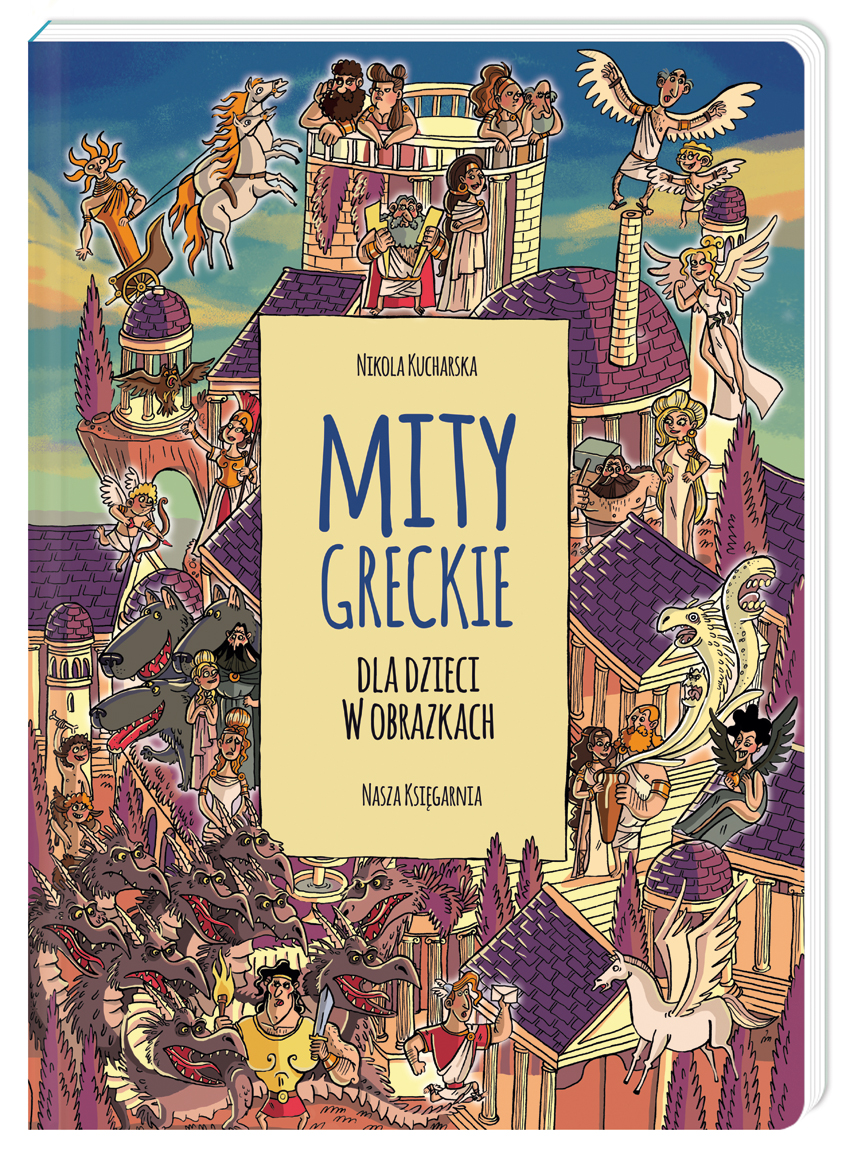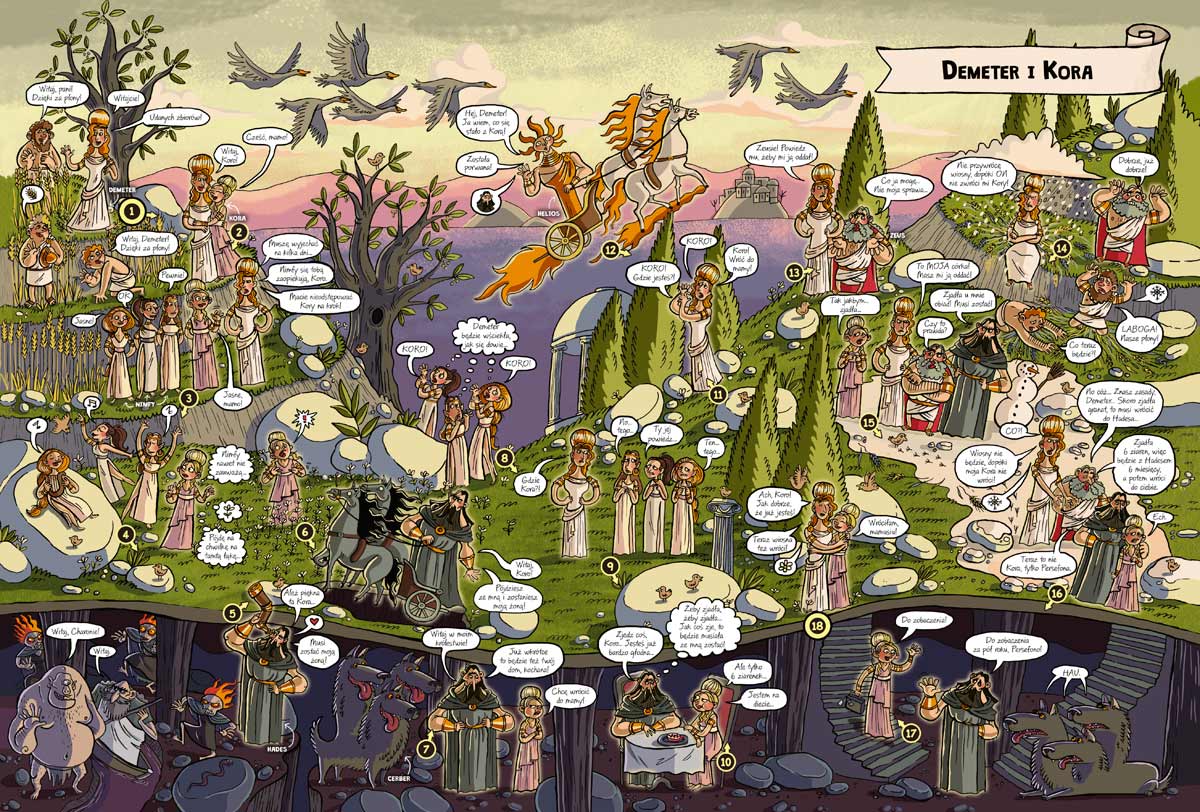Title of the work
Country of the First Edition
Country/countries of popularity
Original Language
First Edition Date
First Edition Details
Nikola Kucharska, Mity greckie dla dzieci w obrazkach [Greek Myths for Children in Pictures]. Warsaw: Nasza Księgarnia, 2017, 16 pp.
ISBN
Available Onllne
Partly here (accessed: July 10, 2018).
Genre
Comics (Graphic works)
Myths
Short stories
Cover

Courtesy of Nasza Księgarnia, publisher.
Author of the Entry:
Hanna Zarzycka, University of Warsaw, hanna.zarzycka@student.uw.edu.pl
Peer-reviewer of the Entry:
Elżbieta Olechowska, University of Warsaw, elzbieta.olechowska@gmail.com
Lisa Maurice, Bar-Ilan University, lisa.maurice@biu.ac.il

Courtesy of the Illustrator.
Nikola Kucharska
, b. 1993
(Author)
Nikola Kucharska was born on November 2, 1993 in Chorzów, Poland. She is a graphic designer, illustrator and author of comic books, and illustrator of board games. She holds a B.A., from the Academy of Fine Arts in Katowice. She has illustrated many children’s books, such as Dorota Wieczorek’s Strachopolis [Monsteropolis] (2015) and Katarzyna Wasilkowska Królestwo jakich wiele [A Kingdom Like Many Others] (2016), and also authored her own books, including Podróż dookoła świata. Północ – południe, wschód – zachód [A Journey Around the World: North – South, East – West] (2016), nominated for “The Most Beautiful Book of the Year” award by the Polish Association of Book Publishers, Kobo w supermarkecie [Kobo in a Supermarket] (2017), co-created with Michał Kubas, and Jak to działa? Zwierzęta [How Does It Work? Animals] (2017). Among her works, there are also wimmelbooks retelling well-known stories: Legendy polskie dla dzieci w obrazkach [Polish Legends for Children in Pictures] (2016) and Greek Myths for Children in Pictures [Mity greckie dla dzieci w obrazkach] (2017). Her works have been translated into several languages and published, inter alia, in France, China, Russia, and Czechia. On her website, she describes herself as a reader of everything, from shampoo labels to classical literature. She collects rubber bands, birds’ feathers and antiques. As a hobby, she writes short stories on an old typewriter. She also admits on her website to owning three black cats and one brownish grey (see here, accessed: June 28, 2018).
Bio prepared by Hanna Zarzycka, University of Warsaw, hanna.zarzycka@student.uw.edu.pl and Maciej Skowera, University of Warsaw, mgskowera@gmail.com
Summary
The book presents seven most popular Greek myths in a comic book style, using illustrations with almost no words. Every myth has its own two pages and can be viewed on vertically or horizontally displayed page. The myths in the book are presented chronologically, after a short summary of all seven myths at the beginning, the reader enters the world of unknown or misunderstood mythology. The first myth shows the creation of the world. The comic book style presentation leads the viewer from illustration to illustration. On the first two pages we see the beginning, the gods Uranus and Gaia and their story leading to the birth of Cronus who will defeat his father and save his siblings. Then the plot passes on to the birth of Zeus as he also fights his father, eventually becomes the master of Olympus and rules the whole world with his brothers and sisters.
The next two pages show Olympus and all mythical gods and creatures, from well known, such as Athena or Poseidon, to less known, such as Morpheus or Tantalus. Every character has its own short description.
After that, the next two pages revolve around the myth of Prometheus. Just like in the first narrative, numbers lead the viewer through the story of creation of humans.
The next myth shows the story of Demeter and her daughter Persephone. It explains to the child why there are seasons in the world. Again, numbered plates lead along the storyline from happy life of mother and daughter to Hades’ passion for Persephone.
After that myth, the reader looks at the story of Pandora. Beginning with Zeus asking Hephaistos to create a beautiful woman with powers and gifts from other gods and ending with her opening a mysterious box and releasing sickness, pain, fever, plague, fear and sadness.
Then comes the turn of Daedalus and Icarus. We see Daedalus and the labyrinth he built for the Minotaur, which pleased king Minos so much that he does not want the architect to leave the island. Yet, Daedalus doesn’t want to be kept captive on Crete and decides to fly from the island together with his son, Icarus, on wings built by him. Unfortunately, Icarus flies too close to the sun and the wax keeping together the feathers in his wings melts, the wings disintegrate and the boy falls into the sea.
The final myth describes the twelve labours of Heracles. Every labour is labelled with a number.
Analysis
Every myth is shown precisely, the illustrations speak for themselves mostly. Numbers keep the child entertained and interacting because they go through the pages. Colours and characters are presented nicely and in modern style which also attracts the reader who could expect more similarity to ancient paintings. The form is easily taken in by the young viewer. The book does not only depict the main myth but around it mythical life going on and other characters from different myths. Also some short texts simplify those myths which have less happy endings; for example, after the death of Icarus, Amphitrite asks her husband to help the young boy and even though Poseidon doesn’t do that, he says that later people will honour this boy by naming the sea from his name – Icarian Sea.
The author must have used her knowledge of mythology from secondary sources, such as Mythology by Jan Parandowski, or The Greeks Myths by Robert Graves.
This short comic book is a successful attempt at presenting myths to the youngest readers. It includes the most popular “origin” stories which provide answers and explanations to many typical questions children are fond of asking. It’s a good start and appealing introduction to Greek mythology.
Addenda

An illustration, pp. 10–11, courtesy of Nasza Księgarnia, publisher.
Mity greckie dla dzieci w obrazkach [Greek Myths for Children in Pictures] is a second book in the „Illustrated Books for Children” series. The first one was Legendy polskie dla dzieci w obrazkach [Polish Legends for Children in Pictures].


